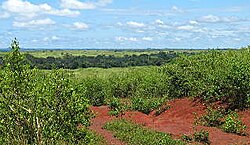
The South Cameroon Plateau or Southern Cameroon Plateau (French: Plateau Sud-Camerounais) is the dominant geographical feature of Cameroon. The plateau lies south of the Adamawa Plateau and southeast of the Cameroon Range. It slopes south and west until giving way to the Cameroon coastal plain in the southwest and the Congo River basin in the southeast. The plateau is characterised by hills and valleys in the southwest and a more gentle peneplain in the southwest. Isolated massifs occur, especially in the southwest. Metamorphic rocks make up the plain's basement. The soils are ferrallitic and lateritic, with colouration ranging from red or brown in the interior to yellow on the coast. The soils are subjected to silica leeching, so they are not productive without fertiliser.
The plateau experiences four major seasons, two rainy, and two dry. Rainfall is high, especially along the coast. The average temperature changes little from 25°C. Rivers in the region drain into the Atlantic Ocean and the Congo River basin. South of the Sanaga, those rivers flow steadily year-round, but the Sanaga and rivers north have a complex regime characterised by high- and low-water periods upstream and constant flow downstream. The predominant vegetation is rainforest, especially to the plateau's south. To the north, forests give way to savanna.